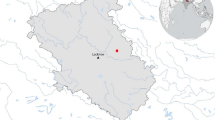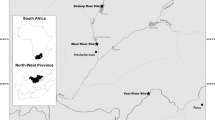Abstract
The metacercariae of Clinostomum species which known as yellow grubs have zoonotic potential by infecting humans. In the present study, a total of 403 freshwater fish specimens belonging to different genera from Central Anatolia Region of Turkey were examined for yellow grub metacercariae infections. Only three specimens belonging to Squalius cephalus were found to be infected with metacercariae with a prevalence on this host species of 2.4% and an overall prevalence of 0.7%. All the metacercariae were morphologically identified as Clinostomum complanatum. Partial fragments of mitochondrial cytochrome oxidase I (mt-COI) gene and internal transcribed spacer 2 (ITS-2) were amplified for sequence and phylogenetic analyses. The sequence analyses of ITS-2 and mt-COI revealed three and nine polymorphic sites leading to detection of four and five haplotypes within the related gene regions, respectively. Moreover, the intraspecific genetic distances for C. complanatum isolates ranged from 0.0 to 0.7% for ITS-2 and 0.0 to 1.4% for mt-COI data sets. Consequently, the present study has provided first combined morphologic and molecular data on C. complanatum infecting Turkish freshwater fishes.



Similar content being viewed by others
References
Acosta AA, Caffara M, Fioravanti ML, Utsunomia R, Zago AC, Franceschini L, Jos’e da Silva R (2016) Morphological and molecular characterization of Clinostomum detruncatum (Trematoda: Clinostomidae) metacercariae infecting Synbranchus marmoratus. J Parasitol 102(1):151–156
Blasco-Costa I, Cutmore SC, Miller TL, Nolan MJ (2016) Molecular approaches to trematode systematics: ‘best practice’ and implications for future study. Syst Parasitol 93:295–306
Buchmann K (2007) An introduction to fish parasitological methods-classical and molecular techniques. Biofolia Press, Copenhagen
Bullard SA, Overstreet RM (2008) Digeneans as enemies of fishes. In: Eiras JC, Segner H, Wahli T, Kapoor BG (eds) Fish diseases, vol 2. Science Publishers, Enfield, Jersey, pp 817–976
Caffara M, Locke SA, Echi PC, Halajian A, Benini D, Luus-Powell WJ, Tavakol S, Fioravanti ML (2017) Morphological and molecular study of Clinostomid metacercariae from African fish with a redescription of Clinostomum tilapiae. Parasitology 144:1519–1529
Caffara M, Bruni G, Paoletti C, Gustinelli A, Fioravanti ML (2014) Metacercariae of Clinostomum complanatum (Trematoda: Digenea) in European newts Triturus carnifex and Lissotriton vulgaris (Caudata: Salamandridae). J Helminthol 88:278–285
Caffara M, Locke SA, Gustinelli A, Marcogliese DJ, Fioravanti ML (2011) Morphological and molecular differentiation of Clinostomum complanatum and Clinostomum marginatum (Digenea: Clinostomidae) metacercariae and adults. J Parasitol 97:884–891
Chung DI, Moon CH, Knong HH, Chai DW, Lim DK (1995) The first human case of Clinostomum complanatum (Trematode: Clinostomidae) infection in Korea. Korean J Parasitol 3:219–223
Colak HS (2013) Metazoan parasites of fish species from Lake Sığırcı (Edirne, Turkey). Turk J Vet Anim Sci 37:200–205
Darlington PJ (1957) Zoogeography: the geographical distribution of animals. John Wiley & Sons, Inc, New York
Dzikowski R, Levy MG, Poore MF, Flowers JR, Paperna I (2004) Clinostomum complanatum and Clinostomum marginatum (Rudolphi, 1819) (Digenea: Clinostomidae) are separate species based on differences in ribosomal DNA. J Parasitol 90:413–414
Faaborg J (2005) Overview. In: Greenberg R, Marra PP (eds) Birds of two worlds: the ecology and evolution of migration. Johns Hopkins University Press, Baltimore, pp 127–129
Graczyk T (1991) Variability of metacercariae of Diplostomum spathaceum (Rudolphi 1819) (Trematoda Diplostomidae). Acta Parasitol Pol 36:135–139
Guindon S, Gascuel O (2003) A simple, fast, and accurate algorithm to estimate large phylogenies by maximum likelihood. Syst Biol 52:696–704
Gustinelli A, Caffara M, Florio D, Otachi EO, Wathuta EM, Fioravanti ML (2010) First description of the adult stage of Clinostomum cutaneum Paperna, 1964 (Digenea: Clinostomidae) from grey herons Ardea cinerea L. and a redescription of the metacercaria from the Nile tilapia Oreochromis niloticus niloticus (L.) in Kenya. Syst Parasitol 76:39–51
Hara H, Miyauchi Y, Tahara S, Yamashita H (2014) Human laryngitis caused by Clinostomum complanatum. Nagoya J Med Sci 76:181–185
Huelsenbeck JP, Ronquist F (2001) MRBAYES: Bayesian inference of phylogenetic trees. Bioinformatics 17:754–755
Kanev I, Radev V, Fried B (2002) Family Clinostomidae Luehe, 1901. In: Gibson DI, Jones A, Bray RA (eds) Keys to the Trematoda (Vol. 1), Wallingford, UK, pp 113–120
Kearse M, Moir R, Wilson A, Stones-Havas S, Cheung M, Sturrock S, Buxton S, Cooper A, Markowitz S, Duran C, Thierer T, Ashton B, Mentjies P, Drummond A (2012) Geneious Basic: an integrated and extendable desktop software platform for the organization and analysis of sequence data. Bioinformatics 28:1647–1649
Kifune T, Ogata M, Miyahara M (2000) The first case of human infection with Clinostomum (Trematoda: Clinostomidae) in Yamaguchi Prefecture, Japan (in Japanese). Med Bull Fukuoka Univ 27:101–105
Kimura M (1980) A simple method of estimating evolutionary rate of base substitutions through comparative studies of nucleotide sequences. J Mol Evol 16: 111–120
Kitagawa N, Oda M, Totoki T, Washizaki S, Oda M, Kifune T (2003) Lidocaine spray used to capture a live Clinostomum parasite causing human laryngitis. Am J Otolaryngol 24:341–343
Kushlan JA, Hancock JA (2005) The herons. Oxford University Press, Oxford
Lee GS, Park SW, Kim J, Seo KS, You KW, Chung JH, Moon HC, Hong GY (2017) A case of endoscopically treated laryngopharyngitis resulting from Clinostomum complanatum infection. Korean J Gastroenterol 69(3):177–180
Librado P, Rozas J (2009) DnaSP v5: a software for comprehensive analysis of DNA polymorphism data. Bioinformatics 25:1451–1452
Lo CF, Huber F, Kou GH, Lo CJ (1981) Studies of Clinostomum complanatum (Rud., 1814). Fish Pathol 15:219–227
Locke SA, Caffara M, Marcogliese DJ, Fioravanti ML (2015) A large-scale molecular survey of Clinostomum (Digenea, Clinostomidae). Zool Scr 44:203–217
Matthews D, Cribb TH (1998) Digenetic trematodes of the genus Clinostomum Leidy, 1856 (Digenea: Clinostomidae) from birds of Queensland, Australia, including C. wilsoni n. sp. from Egretta intermedia. Syst Parasitol 39:199–208
Moszczynska A, Locke SA, Mclaughlin DJ, Marcogliese DJ, Crease TJ (2009) Development of primers for the mitochondrial cytochrome c oxidase I gene in digenetic trematodes (Platyhelminthes) illustrates the challenge of barcoding parasitic helminthes. Mol Ecol Resour 9:75–82
Olsen WO (1974) Animal parasites: their life cycles and ecology. University Park Press, Baltimore, Maryland
Ozturk T, Ozer A (2015) Endemic Aphanıus danfordii (Pisces: Cyrinodontiformes): a new host species of Clinostomum complanatum Metacercariae (Digenea). 17th International Conference on Diseases of Fish and Shellfish, 7–11 September 2015, Las Palmas De Gran Canaria
Park CW, Kim JS, Joo HS, Kim J (2009) A human case of Clinostomum complanatum infection in Korea. Korean J Parasitol 47:401–404
Pérez-Ponce De León G, García-Varela M, Pinacho-Pinacho CD, Sereno-Uribe AL, Poulin R (2016) Species delimitation in trematodes using DNA sequences: Middle-American Clinostomum as a case study. Parasitology 143:1773–1789
Posada D (2008) jModelTest: phylogenetic model averaging. Mol Biol Evol 25:1253–1256
Rosser TG, Alberson NR, Woodyard ET, Cunningham FL, Pote LM, Griffin MJ (2017) Clinostomum album n. sp. and Clinostomum marginatum (Rudolphi, 1819), parasites of the great egret Ardea alba L. from Mississippi, USA. Syst Parasitol 94:35–49
Sereno-Uribe AL, Pinacho-Pinacho CD, García-Varela M, de León GP (2013) Using mitochondrial and ribosomal DNA sequences to test the taxonomic validity of Clinostomum complanatum Rudolphi, 1814 in fish-eating birds and freshwater fishes in Mexico, with the description of a new species. Parasitol Res 112:2855–2870
Skov J, Kania PW, Dalsgaard A, Jørgensen TR, Buchmann K (2009) Life cycle stages of heterophyid trematodes in Vietnamese freshwater fishes traced by molecular and morphometric methods. Vet Parasitol 160:66–75
Soylu E (2014) Metazoan parasites of fish species from Lake Gala (Edirne, Turkey). Ege J Fish Aqua Sci 31(4):187–193
Soylu E (2013) Metazoan parasites of perch Perca fluviatilis L. from Lake Sığırcı, Ipsala, Turkey. Pak J Zool 45(1):47–52
Steenkiste NV, Locke SA, Castelin M, Marcogliese DJ, Abbott CL (2015) New primers for DNA barcoding of digeneans and cestodes (Platyhelminthes). Mol Ecol Resour 15:945–952
Sutili FJ, Gressler LT, Pelegrini LFV (2014) Clinostomum complanatum (Trematode, Digenea): a parasite of birds and fishes with zoonotic potential in southern Brazil: a review. Revista Brasileira de Higiene e Sanidade Animal 8:99–114
Tamura K, Stecher G, Peterson D, Filipski A, Kumar S (2013) MEGA6: molecular evolutionary genetics analysis version 6.0. Mol Biol Evol 30:2725–2729
Ukoli FMA (1966) On Clinostomum tilapiae n. sp., and C. phalacrocoracis Dubois, 1931 from Ghana, and a discussion of the systematics of the genus Clinostomum Leidy, 1856. J Helminthol 40:187–214
Vianna RT Jr, Pereira J, Brandão DA (2003) Ontogenetic variation of metacercariae of Clinostomum complanatum (Rudolphi, 1814) (Digenea: Clinostomidae). Comunicações do Museu de Ciências e Tecnologia da PUCRS, Série Zoologia, Porto Alegre 16:223–243
Vilas R, Criscione CD, Blouin MS (2005) A comparison between mitochondrial DNA and ribosomal internal transcribed regions in prospecting for cryptic species of platyhelminth parasites. Parasitology 131:839–846
Yamaguti S (1971) Synopsis of digenetic trematodes of vertebrates, vol Vol. 1. Keigaku Publishing Co, Tokyo, Japan
Yamashita J (1938) Clinostomum complanatum, a trematode parasite new to man. Annot Zool Jpn 17:563–566
Wang ML, Chen HY, Shih HH (2017) Occurrence and distribution of yellow grub trematodes (Clinostomum complanatum) infection in Taiwan. Parasitol Res 116(6):1761–1771
Funding
This work was funded by the Erciyes University Scientific and Technological Research Center, Kayseri, Turkey (project number, TCD-2016-6795).
Author information
Authors and Affiliations
Corresponding author
Ethics declarations
Conflict of interest
The authors declare that they have no conflict of interest.
Additional information
Section Editor: Guillermo Salgado-Maldonado
Rights and permissions
About this article
Cite this article
Simsek, E., Yildirim, A., Yilmaz, E. et al. Occurrence and molecular characterization of Clinostomum complanatum (Trematoda: Clinostomidae) in freshwater fishes caught from Turkey. Parasitol Res 117, 2117–2124 (2018). https://doi.org/10.1007/s00436-018-5898-3
Received:
Accepted:
Published:
Issue Date:
DOI: https://doi.org/10.1007/s00436-018-5898-3




